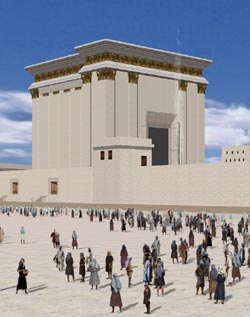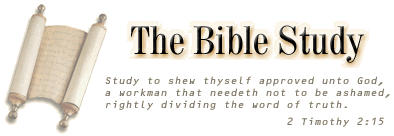 |
The Temple Mount
in the
First and Second Temple Periods
Shortly after David conquered Jerusalem from the Jebusites, he built an altar to the God of Israel on a threshing-floor, bought for fifty
sheckels from Ornan-Araunah the Jebusite, king of Jerusalem (2 Samuel 24:24–25). This was the site of the Temple built by King Solomon: "Then Solomon began to build the house of the Lord at Jerusalem in mount Moriah, where [the Lord] appeared unto David his father; for which provision had been made in the Place of David, in the threshing-floor of Ornan the Jebusite" (2 Chronicles 3:1).
The First Temple, built with the assistance of Hiram, king of Tyre, and of Sidonian artisans, replaced the Tabernacle; the sacred implements that had been used in the latter, including in particular the Ark of the Covenant, were transferred to the Temple. The First Temple remained standing throughout the days of the kingdom of Judah, some four hundred years, until it was destroyed in 586 BCE by Nebuchadnezzar, king of Babylon, who also exiled the people of Judah to Babylon.
After about fifty years in exile, the deportees from Judah were permitted by Cyrus, king of Persia, who had seized control of Babylon, to return home and rebuild the Temple: "Thus saith Cyrus king of Persia: All the kingdoms of the earth hath the Lord, the God of Heaven, given me; and He hath charged me to build Him a house in Jerusalem, which is in Judah" (Ezra 1:2).
Despite many obstacles, the Second Temple was finally erected in Jerusalem by the returnees, led by Zerubbabel. It was consecrated around 516 BCE and remained standing in some six hundred years.
| Our knowledge of the early history of the Second Temple is meager. Dramatic events took place when the Seleucid king Antiochus IV Epiphanes issued his decrees against observing the commandments of the Jewish religion in Judea and elsewhere; these actions provoked the Hasmonean Revolt, at the peak of which Judas Maccabeus reoccupied the Temple, cleansed it and re-consecrated it on the twenty-fifth day of the month of
Kislev, 164 BCE.
When Herod seized power and became king of Judea, he decided to enlarge the area of the Temple Mount and the Temple itself
(see illustration right, and Jewish Antiquities, Book 15, Chapter 11,
382-387)
|
  |
This tremendous construction project - the greatest in the history of the Land of Israel and one of the greatest in the world at the time -involved several main elements: a new temple replaced the one erected by the returnees; the Temple Mount was enlarged resulting in a tremendous precinct, 480 meters long and 280 meters wide; the Royal Stoa was ; the entire area around the Temple Mount was redesigned and rebuilt, including entrance-gates and flights of stairs, streets, a drainage system, public plazas
and a considerable number of Ritual Baths in which worshipers could purify themselves before entering the sacred enclosure.
Josephus recounts that the erection of the walls of the temple enclosure took Herod eight years to complete, while the building of the Temple itself lasted one year and five months. Ten thousand workers were employed and one thousand carts were needed to transport the building blocks - another indication of the exceptional scale of the construction.
Abutting the inner south wall of the Temple Mount (the present-day site of the Al-Aqsa Mosque) Herod built the ‘Royal Stoa’. Nothing has survived of this building, which was razed to the ground when the Roman legions destroyed Jerusalem, but it was described as the most magnificent building ever built in the Land of Israel and one of the largest in the ancient world (Josephus, Jewish
Antiquities, Book 15, Chapter 11, 410).
The Royal Stoa was approximately 180 meters long, its entire length open onto the Temple Mount court. Its roof rested on four rows of columns, forty to each row. The stone elements were carved featuring stylized flowers, leaves and geometric motifs. A few carved stones, uncovered south of the south wall of the Temple Mount, provide evidence of the magnificence of the building.
The Royal Stoa was used for the secular affairs, such as the purchase and sale of animals for sacrifices, and the exchange of coins for Tyrian
half-sheckels which were regularly paid by pilgrims as tax for the Temple upkeep (Exodus 30:11-16). It was probably here that, as related in the New Testament, Jesus overturned the moneychangers’ tables (Matthew
21:12). The Stoa was probably a venue for sermons, as well as conversations and discussions on various social matters.
On the ninth and tenth days of the month of Av in the year 70 CE, after a four-months-siege, the Roman army broke through to the Temple Mount and set the Temple afire. Neither the First nor the Second Temples have left any vestiges on the Temple Mount; all we have today are the literary accounts - the Bible, the writings of Josephus and the Rabbinic literature. Nevertheless, considerable segments of the Temple Mount walls have survived, and they provide visual evidence of the magnitude and
grandeur of the precinct.

|
|

